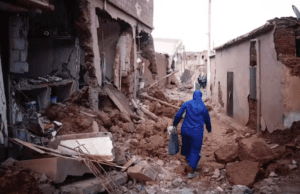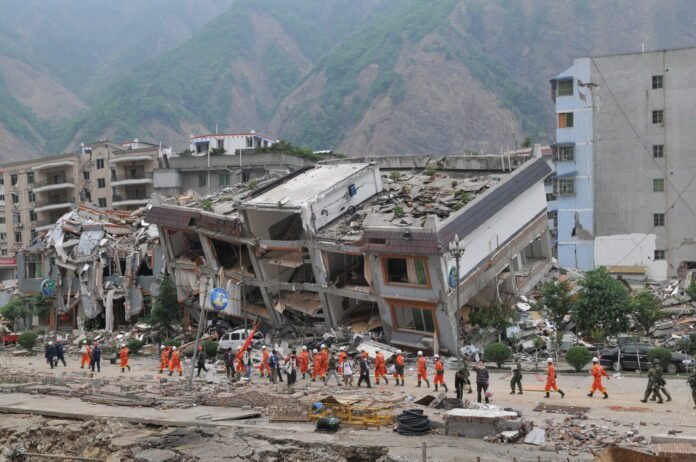More people have died in the earthquake in China, with 131 people now confirmed dead. People who have survived are hoping that rescuers will save their family members who are trapped under collapsed buildings.
3 min read 2023-12-20, 09:00 PM IST
Summary of the content
- Magnitude 6.2 earthquake hits Jishishan county, Gansu province, China.
- 134 dead, 968 injured; extensive infrastructure damage reported.
- Sub-zero temperatures complicate rescue efforts.
- Gansu reports 113 dead, 782 injured, concluding search operations.
- Qinghai records 21 dead, 186 injured, and 13 missing.
- Complex terrain and high altitude (1,800 to 4,300 meters) challenge rescuers.
- Rescue operations shift focus to treating survivors as winter approaches.
- Over 207,000 homes destroyed; emergency supplies delivered.
- Survivor struggles include makeshift shelters, limited food, and risk of hypothermia.
- Quake affects 22 towns and villages; mudslides complicate rescue in some areas.
- Concerns about potential aftershocks prompt warnings and ongoing monitoring.
- Shallow earthquake depth (10 km) intensifies ground damage.
- History of earthquakes in the region, notably the 2008 Sichuan quake.
- Urgency for comprehensive disaster response strategies and coordinated relief efforts.
 In the aftermath of the devastating earthquake that struck Jishishan county in Gansu province, China, the magnitude 6.2 seismic event sent shockwaves through the region, causing widespread destruction and leaving a trail of despair. The epicenter’s proximity to the border of Gansu and Qinghai provinces added complexity to the rescue and recovery efforts. As rescuers braved sub-zero temperatures, the scale of the disaster unfolded, revealing the urgent need for comprehensive relief measures.
In the aftermath of the devastating earthquake that struck Jishishan county in Gansu province, China, the magnitude 6.2 seismic event sent shockwaves through the region, causing widespread destruction and leaving a trail of despair. The epicenter’s proximity to the border of Gansu and Qinghai provinces added complexity to the rescue and recovery efforts. As rescuers braved sub-zero temperatures, the scale of the disaster unfolded, revealing the urgent need for comprehensive relief measures.
The earthquake, occurring at a precarious minute before midnight on Monday, caught residents off guard, forcing them out of their homes into the biting cold of the night. The immediate aftermath witnessed a flurry of emergency responses as authorities grappled with the enormity of the situation. Roads, power lines, water infrastructure, and agricultural facilities bore the brunt of the seismic force, leading to extensive damage and complicating rescue operations.
Gansu province reported 113 casualties and 782 injuries by 9 a.m. on Wednesday, underscoring the severity of the impact. In neighboring Qinghai, the death toll rose to 21, with 186 injured and 13 still missing as of 4 p.m. on the same day. The numbers painted a grim picture of the human toll, leaving families shattered and communities grappling with the aftermath of the disaster.
ALSO READ: Train Breaks in Two: Over 100 Injured in Beijing as Carriages Separate Due to Icy Tracks.
Rescue operations in Gansu concluded on Tuesday afternoon, marking a transition from the initial search for survivors to the crucial phase of treating the wounded and providing essential support. The focus shifted towards addressing the immediate needs of those affected, particularly as a harsh winter loomed on the horizon. The decision reflected the acknowledgment of the challenges posed by the region’s complex terrain, compounded by the sub-zero conditions.
The quake’s impact went beyond the loss of life and injuries; it wreaked havoc on the region’s infrastructure. More than 207,000 homes were destroyed, and nearly 15,000 collapsed in Gansu, affecting over 145,000 people. The immediate response included the delivery of over 128,000 emergency supply items, including tents, quilts, tent lights, and folding beds. Food provisions, such as steamed buns and instant noodles, were distributed to sustain the victims amid the unfolding crisis.
- The affected area, situated in a geographical transition zone between two plateaus, presented unique challenges for rescue and recovery teams. With terrains ranging from 1,800 to 4,300 meters in altitude, the topography proved “very complex,” adding to the difficulties faced by responders.
- The post-quake recovery efforts were further hampered by an intense cold snap that gripped most of China since the previous week. On Tuesday night, temperatures around the epicenter plummeted to approximately minus 15 degrees Celsius (5 degrees Fahrenheit), intensifying the struggle for survival for those exposed to the elements.
- Local media, citing researchers, highlighted the critical risks faced by people trapped under rubble in sub-zero conditions. Even if uninjured, individuals in such circumstances could succumb to rapid hypothermia within five to ten hours. This stark reality underscored the race against time for rescuers to locate and extract survivors before the harsh environment claimed more lives.
- In the quake-hit city of Haidong in Qinghai, personal stories of resilience and survival emerged amid the devastation. Du Haiyi, a 21-year-old resident, recounted the harrowing experience of saving his mother and 16-year-old sister trapped under debris. Their family home had been completely leveled, leaving them with no choice but to rely on makeshift shelters provided by the local government.
- Du’s account mirrored the struggles faced by many in the quake-affected areas. Families, now without homes, had few options but to gather in fields, burning wheat straw for warmth. The limited availability of emergency tents, prioritized for the elderly and young, left some families with no choice but to seek refuge in whatever shelter they could find, including vehicles.
- Beijing Youth Daily reported a poignant example of a family of seven spending the night in a car as they awaited assistance. Within a 50-kilometer radius of the quake’s epicenter on the edge of Qinghai province, the earthquake affected 22 towns and villages.
ALSO READ: China Reiterates Ownership Claims Over Ladakh’s Western Border.
- Two villages, however, bore the brunt of the damage, with the county of Minhe in Haidong recording 20 missing people. A mudslide swept through the villages, burying many buildings in brown silt and complicating search and rescue operations. The challenges faced by rescuers included blocked main roads, hindering access to the affected areas. State media showcased footage of bulldozers tirelessly clawing through mud and rubble, highlighting the relentless efforts to reach those in need. The difficulties in transportation added an additional layer of complexity to the overall relief efforts, emphasizing the need for coordinated and efficient logistics.
- In Haidong, rescue volunteers like Wu Saying, 21, worked tirelessly to provide assistance. Armed with coats designed for extreme cold, heating equipment, and other essentials, these volunteers faced not only the physical challenges of the rescue operation but also the emotional toll of witnessing the widespread devastation.
- Food supplies emerged as a critical concern in the aftermath of the quake. Bao Yinzi, 53, highlighted the stark reality of having nothing to eat, resorting to consuming whatever remained in the house. The destruction of infrastructure, including kitchen utensils, left many families without the means to prepare meals. The immediate focus on survival meant that basic necessities, such as food and water, became urgent priorities for both affected individuals and the relief efforts.
- The earthquake’s impact extended beyond the immediate aftermath, with the frigid cold not being the sole concern for rescuers. The Gansu Provincial Seismological Bureau issued warnings about the potential for strong aftershocks in the coming days. Based on the characteristics of the initial quake, historical seismic activity, and other factors, monitoring aftershocks became a critical aspect of the ongoing response.
- By early Wednesday, the China Earthquake Networks Center reported two aftershocks of magnitude 4.0 and above, along with eight of magnitude 3.0 and above. The unpredictability of aftershocks added a layer of uncertainty to the already challenging environment for both rescuers and survivors. The continuous tracking of aftershocks became crucial for issuing early warnings and ensuring the safety of those involved in relief operations.
- The seismic nature of the earthquake, centered in Gansu’s Jiashan county at a depth of 10 km (6.2 miles), was considered shallow. Shallow focal points in earthquakes can cause considerable damage to the ground, intensifying the impact on structures and infrastructure. A senior engineer with the China Seismological Network Center emphasized this point, highlighting the need for a comprehensive understanding of the seismic characteristics to inform ongoing response efforts.
- Earthquakes are unfortunately not uncommon in Chinese provinces like Gansu, which lie on the northeastern boundary of the tectonically active Qinghai-Tibetan plateau. The region’s history bears witness to seismic events, with the 2008 Sichuan earthquake standing out as one of China’s deadliest in recent decades. The magnitude 8.0 temblor claimed nearly 70,000 lives, leaving a lasting impact on the affected communities and shaping disaster response strategies.
- As the current earthquake unfolded, the complexities of responding to such a crisis became apparent. The multidimensional challenges included the geographical intricacies of the affected area, the harsh weather conditions, and the urgent need for coordinated relief efforts.


Excellent write-up